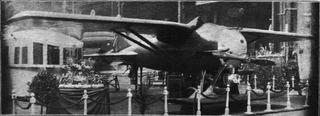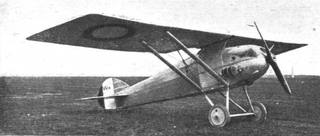The Blériot-SPAD S.81 was a French fighter aircraft developed in 1923 to a requirement by the French Air Force. It was flown competitively against the Dewoitine D.1 and was selected over that aircraft due to the Dewoitine's more radical design, leading to an order for 80 aircraft. The S.81 was a single-bay biplane of conventional configuration with I-shaped interplane struts and lacking Herbemont's usual swept upper wing. It featured a wooden fuselage of monocoque construction and metal wings skinned in fabric. Production versions differed from the prototypes in having a lengthened fuselage and larger tail fin.

The Fokker D.IX was a Dutch single seat, single engine fighter aircraft, the final, more powerful evolution of the Fokker D.VII World War I success, flown in 1921. The sole example was purchased by the US Army Air Service but not developed further.

The Nieuport-Delage NiD 37 was a single-engine, single-seat monoplane fighter aircraft and racer designed and built in France in the early 1920s. It had a small foreplane to bring the centre of pressure forward. Heavy, slower than expected and with turbo-supercharger problems, development ended without any entering service.

The Nieuport-Delage NiD 43 was a single engine, two seat biplane fighter aircraft designed and built for shipboard use in France in 1924.
The Wibault Wib 1, Wib C1 or, later, Wib 1 C1 was a French World War I single seat, single engine fighter aircraft prototype. Flown near the end of the war, it was not selected for production.

The Wibault 3 or Wibault Wib 3 C.1 was a French parasol wing prototype fighter aircraft from the 1920s, designed for high altitude operations. Its development was abandoned after repeated materials failure in its supercharger.

The Wibault 8 or Wib 8 Simoun (Simoon) was a tandem seat, parasol wing fighter aircraft designed and built in France to a 1925 specification which was later withdrawn; only one Wib 8 was completed.

The Wibault 12 Sirocco or Wib 12 Sirocco was a two-seat, parasol wing fighter aircraft designed and built in France in the 1920s. Three fighter prototypes were completed, one for the RAF and two Army co-operation variants. There was no series production.

The Wibault 13C.1 Trombe (Whirlwind), later known as the Wib 130C.1 Trombe was a single seat, parasol wing lightweight fighter aircraft designed and built in France in the 1920s. It was developed into the more powerful Wib 170C.1 Tornade (Tornado) but government interest in lightweight fighters soon waned.
The Wibault Wib 210 C.1 was a single engine, single seat low wing monoplane fighter aircraft, designed and built in France in the late 1920s. Flight tests revealed vibration problems and development was quickly abandoned.
The Letov Š-7 was a single-seat, single-engine biplane fighter aircraft designed and built in Czechoslovakia in the early 1920s. It was designed for a single-seat fighter competition but did not reach production.
The Letov Š-13 was a single-seat, single-engine fighter aircraft designed and built in Czechoslovakia in the early 1920s. A biplane, it had aerodynamically thick wings which were originally cantilever structures, though interplane struts were later added. Only one was produced.

The Letov Š-14 was a single-seat, single-engine aircraft, designed and built in Czechoslovakia in the early 1920s. Originally intended as a biplane fighter, it was later modified into a monoplane and entered as a contestant in a speed competition.
The Letov Š-22 was a single-seat, single-engine aircraft designed and built in Czechoslovakia in the mid-1920s. A parasol-wing Dewoitine-style fighter, it was not successful, and only one was built.
The Dewoitine D.15 was a single-engine, single-seat biplane fighter aircraft built in France in the 1920s. Intended to offer structural simplifications when compared with monoplanes, it had a disappointing performance and was soon abandoned.
The Hanriot HD.5 was a French two-seat fighter aircraft prototype, built towards the end of World War I. A single-engine biplane with an unusually narrow gap between the upper and lower wings, it did not enter production.

The Hanriot HD.15 was a French two seat fighter aircraft fitted with a supercharger for good high altitude performance, built in the 1920s. Three were ordered by Japan but lost at sea during delivery.
The Descamps 27 C1 was a single seat biplane fighter aircraft, built in France in 1919. It was unusual in having a forward swept lower wing. After competitive trials, the Nieuport 29 was chosen for production, so only one Descamps was built.

The de Marçay 2 C1 was a single seat biplane fighter designed in France and first flown in 1919. It did not go into production.
The Villiers VIII or 8amC1 was a French shipboard fighter capable of alighting on water. After competitive tests it did not receive a production order.



















